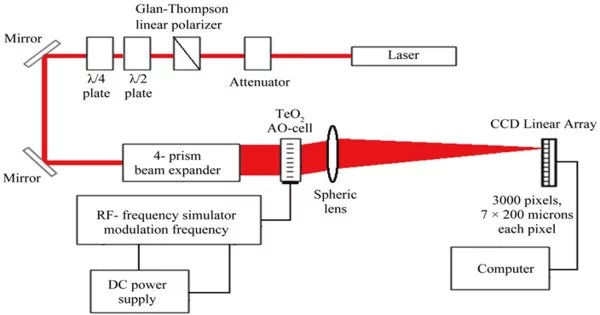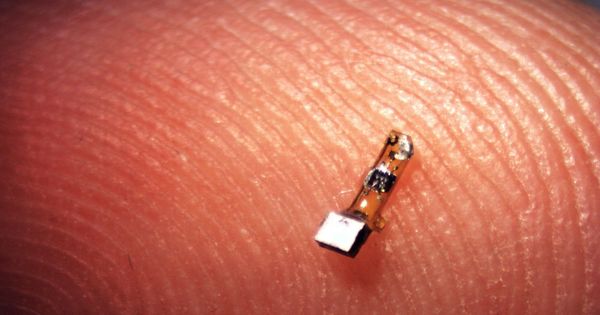The acousto-optical spectrometer (AOS) is based on the diffraction of light by ultrasonic vibrations. It is a sort of optical device used to analyze the spectrum of light. A piezoelectric transducer, controlled by the RF signal (from the receiver), generates an acoustic wave in a crystal (the so-called Bragg-cell). This acoustic pulse modifies the refractive index and causes a phase grating. A collimated laser beam illuminates the Bragg cell.
It uses acousto-optic principles to separate and measure the different wavelengths (colors) of light in a particular input beam. This device is commonly used in spectroscopy and other light-analysis applications, such as scientific research, industrial quality control, and telecommunications.
According to the amplitude and wavelengths of the acoustic waves in the crystal, the angular dispersion of the diffracted light represents a true image of the IF-spectrum. A single linear diode array (CCD) positioned in the focal plane of an imaging optics detects the spectrum. The resolution of this sort of spectrometer can be adjusted depending on the crystal and the focal length of the imaging optics.
Here’s how an acousto-optical spectrometer works:
- Input Light: The spectrometer takes in a beam of light containing a range of wavelengths, such as light from a source, a laser, or a sample being analyzed.
- Acoustic Modulation: An acoustic wave is supplied to the AOM crystal, causing a periodic fluctuation in the material’s refractive index. This sonic wave induces diffraction of the entering light, resulting in the separation of its multiple wavelengths. The angle of diffraction is proportional to the frequency of the acoustic wave and thus controllable.
- Wavelength Separation: The various colors (wavelengths) within the input light are spatially divided into distinct directions as a result of diffraction.
- Detection: To capture the spatial distribution of the diffracted light, a detector, such as a photodetector or a CCD camera, is utilized. The intensity of each wavelength component can be determined by studying the position of the diffracted beams.
- Spectral Analysis: The detected data is processed to generate a spectrum that shows the intensity of light at different wavelengths, creating a detailed representation of the original input light’s spectrum.
Advantages
Acoustic-optical spectrometers have the advantage of being able to swiftly scan and analyze a wide range of wavelengths, making them appropriate for applications such as fluorescence spectroscopy, Raman spectroscopy, and telecommunications. They have a high spectrum resolution and may be utilized with both continuous and pulsed light sources. Furthermore, they provide real-time spectral analysis and are frequently compact and dependable equipment for a variety of scientific and industrial applications.
















